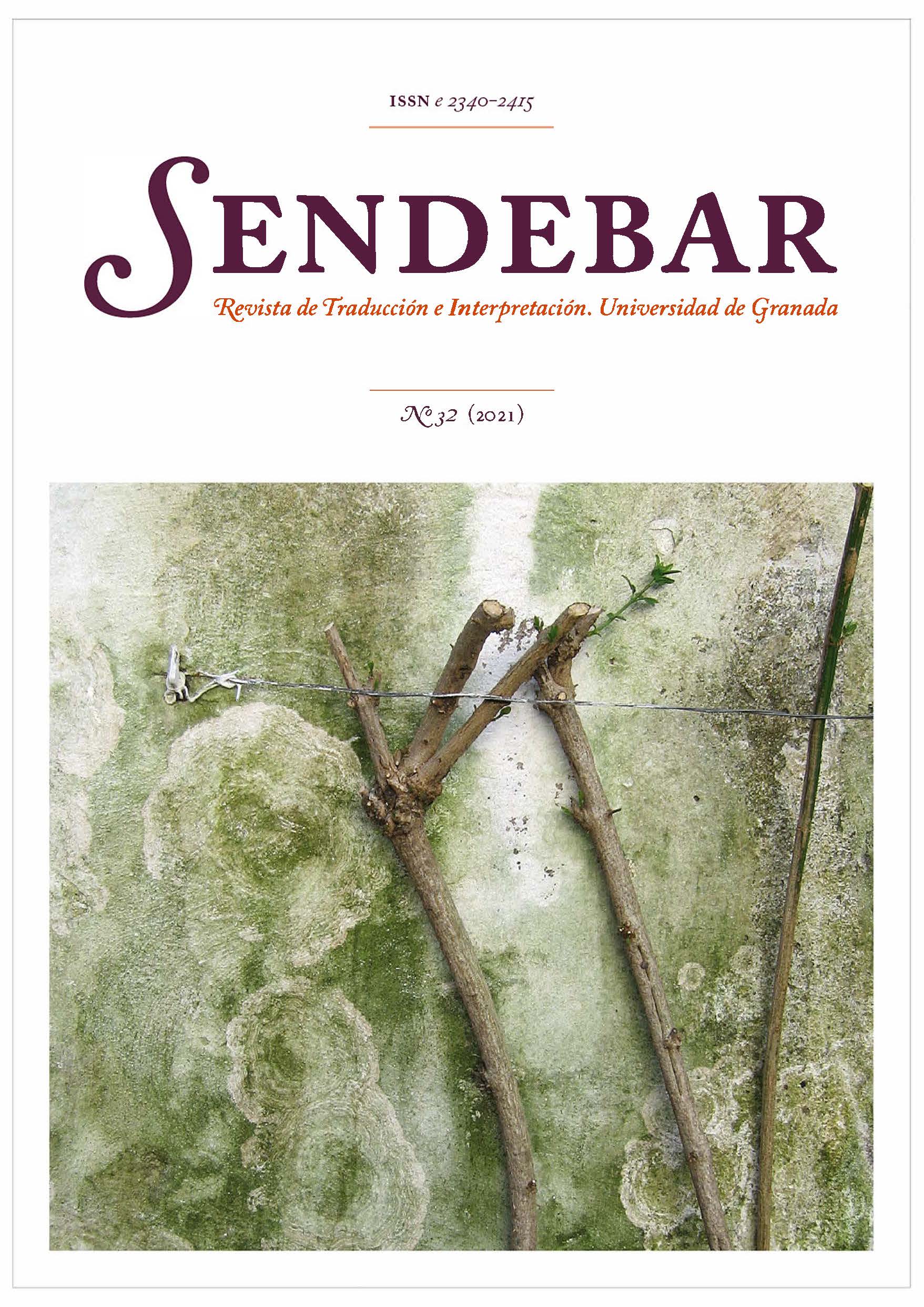Accessibility in 360º Videos: Methodological Aspects and Main Results of Evaluation Activities in the ImAc Project
DOI:
https://doi.org/10.30827/sendebar.v32.16881Keywords:
accessibility, virtual reality, 360º videos, subtitling, audio description, sign language interpretingAbstract
This article presents a global overview of the results of the evaluation activities performed in the European project Immersive Accessibility (ImAc), which investigated how access services can be integrated into 360º videos. More specifically, the paper presents the methodological approach in ImAc testing, and reports on the results of the evaluation activities on the tools (a subtitling editor, an audio description editor, a sign language editor, and an accessibility content manager), on the media player, and on the access services (subtitling, audio description, audio subtitling, and sign language interpreting).
Downloads
References
Agulló, B. (2020). Technology for subtitling: a 360-degree turn. Hermeneus, 22, 11-40.
Agulló, B., & Matamala, A. (2019). Subtitling for the deaf and hard-of-hearing in immersive environments: results from a focus group. Jostrans. The Journal of Specialised Translation, 33, 217-235.
Agulló, B., & Matamala, A. (2020). Subtitles in virtual reality: guidelines for the integration of subtitles in 360º content. Íkala, 25(3), 643-661.
Agulló, B., Matamala, A., & Orero, P. (2018). From disabilities to capabilities: testing subtitles in immersive environments with end users. Hikma, 17, 195-220.
Agulló, B., Montagud, M., & Fraile, I. (2019). Making interaction with virtual reality accessible: rendering and guiding methods for subtitles. Artificial Intelligence for Engineering Design, Analysis and Manufacturing, 33(4), 416-428. https://doi.org/10.1017/S0890060419000362
BBC (n.d.). Reel World. 360° Videos from the BBC. https://www.bbc.com/reel/playlist/reel-world-360-videos-from-the-bbc
Bernabé, R., & Orero, P. (2019). Easy to read as multimodal accessibility service. Hermeneus, 21, 53-74.
Bernabé, R., Orero, P., García, O., & Oncins, E. (2020). Validation of easy-to-read subtitles. In D. Dejica, C. Eugeni, A. Dejica-Cartis (Eds.), Translation Studies and Information Technology – New Pathways for Researchers, Teachers and Professionals (pp. 168-181). Editura Politehnica.
Braun, S., & Orero, P. (2010). Audio description with audio subtitling. Perspectives: Studies in Translatology, 18(3), 173-188.
Brookes, J. (2013). SUS: a retrospective. Journal of Usability Studies, 8(2), 29-40.
Bredel, U., & Maass, Ch. (2016). Leichte Sprache. Theoretische Grundlagen, Orientierung für die Praxis. Duden.
Brown, A., Turner, J., Patterson, J., Schmitz, A., Armstrong, M., & Glancy, M. (2017). Subtitles in 360-degree video. Proceedings of the 2017 ACM International Conference on Interactive Experiences for TV and Online Video, Hilversum, Netherlands, 3-8. https://doi.org/10.1145/3084289.3089915
Brown, A., Turner, J., Patterson, J., Schmitz, A., Armstrong, M., & Glancy, M. (2018). Exploring subtitle behaviour for 360° video (White Paper WHP 330) https://www.bbc.co.uk/rd/publications/whitepaper330
Catapult Digital (2018). Growing VR/AR companies in the UK: A business and legal handbook. https://www.pwc.co.uk/intelligent-digital/vr/growing-vr-ar-companies-in-the-uk.pdf
European Broadcasting Union (EBU). (2017). Virtual reality: How are public broadcasters using it? https://www.ebu.ch/publications/virtual-reality-how-are-public-broadcasters-using-it
Fidyka, A., & Matamala, A. (2018). Audio description in 360º videos: results from focus groups in Barcelona and Kraków. Translation Spaces, 7(2), 285-303.
Fidyka, A., & Matamala, A. (2019). Production of access services in immersive content: understanding the needs of audio describers. Hikma, 18(2), 277-300.
Fidyka, A., & Matamala, A. (2021). Retelling narrative in 360º videos: implications for audio description. Translation Studies. https://doi.org/10.1080/14781700.2021.1888783
Fidyka, A., Matamala, A., Soler-Vilageliu, O., & Arias-Badia, B. (2021). Audio description in 360º content: results from a reception study. Skase, 14(1), 14-32.
Fryer, L., & Freeman, J. (2012). Presence in those with and without sight: Audio description and its potential for virtual reality applications. Journal of Cyber Therapy & Rehabilitation, 5(1), 15-23.
Hughes, Ch., & Montagud, M. (2020). Accessibility in 360º video players. Multimedia tools and applications. https://doi.org/10.1007/s11042-020-10088-0
IFLA (2010). Guidelines for easy-to-read materials. https://www.ifla.org/files/assets/hq/publications/professional-report/120.pdf
Inclusion Europe (2014). Information for all: European standards for making information easy to read and understand. https://inclusion-europe.eu/wp-content/uploads/2015/03/2113-Information-for-all-16.pdf
ISO (1998). ISO 9241-11:1998 Ergonomic requirements for office work with visual display terminals (VDTs) – Part 11: Guidance on usability.
Lombard, L., & Ditton, T. At the heart of it all: The concept of presence. Journal of Computer-Mediated Communication, 3(2). https://doi.org/10.1111/j.1083-6101.1997.tb00072.x
Maszerowska, A., Matamala, A., & Orero, P. (Eds.) (2014). Audio description. New perspectives illustrated. John Benjamins.
Matamala, A. (2020). Deliverable 5.4. Pilot evaluation report. Final deliverable, March 2020.
Matamala, A., & Orero, P. (Eds.) (2010). Listening to subtitles. Subtitling for the Deaf and Hard-of-Hearing. Peter Lang.
McDonald, A. (2012). The in-vision sign language interpreter in British television drama. In A. Remael, P. Orero, & M. Carroll (Eds.), Audiovisual translation and media accessibility at the crossroads (pp. 189-206). Rodopi.
Oncins, E., Bernabé, R., Montagud, M., & Arnáiz Uzquiza, V. (2020). Accessible scenic arts and Virtual Reality. A pilot study with aged people about user preferences when reading subtitles in immersive environments. MonTI, 12, 214-241.
Orero, P. (2020). Born accessible: Beyond raising awareness. https://ddd.uab.cat/record/222130
Reeves, B.R. (1991). Being there: Television as symbolic versus natural experience. Unpublished manuscript, Stanford University, Institute for Communication Research, Stanford, CA.
Rothe, S., Tran, K., & Hussmann, H. (2018). Dynamic subtitles in cinematic virtual reality. ACM TVX 2018, Seoul, Republic of Korea, 209–214. https://doi. org/10.1145/3210825.3213556
Downloads
Published
How to Cite
Issue
Section
License
Terminos de Licencia Sendebar.

















